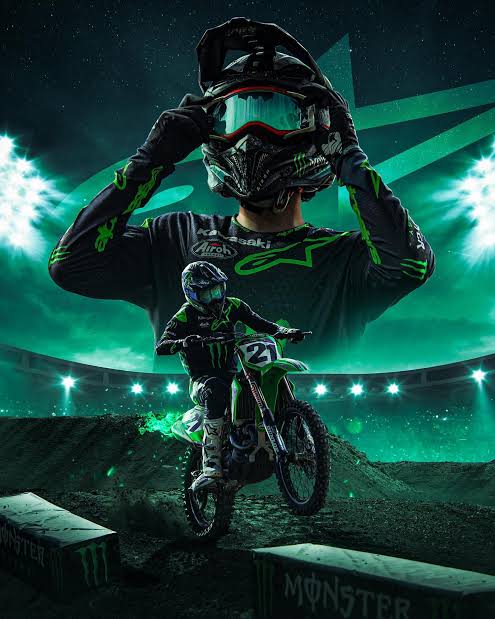A Legend in Bronze: Jason Anderson Immortalized in Mattstedt
In a remarkable gesture of international recognition, the small German town of **Mattstedt**, nestled in the rolling green hills of **Thuringia**, has become the unlikely host to a monumental tribute to one of **America’s most electrifying motocross athletes** — **Jason Anderson**. The **National Sports Centre** of Mattstedt, long a hub for European motorsport enthusiasts, has unveiled a life-sized bronze statue of Anderson, frozen mid-leap, bike twisting beneath him, eyes focused, spirit unyielding.
The scene at the unveiling was one of reverence and exhilaration. Fans, local dignitaries, and motocross legends from across the world gathered under a sky that seemed, for a moment, as if it too bowed in respect. As the curtain fell from the sculpture, a hush overtook the crowd — not for the artistry of the piece alone, but for the history, the fight, the grit, and the raw inspiration it symbolized.
**Jason Anderson** — known by many as “El Hombre” — is not just a racer. He’s a narrative in motion, a testament to perseverance, style, and heart. From his roots in **Edgewood, New Mexico**, to the dazzling stadiums of **Monster Energy AMA Supercross**, Anderson carved a legacy with throttle and tenacity.
He rose to prominence through a sport that spares no one. Every race a test of endurance, every lap a battle between man and machine. He didn’t just race; he **defied gravity**, **pushed limits**, and **made noise in a sport that demands silence from those who fall behind**.
But why Mattstedt? Why a statue here — across the ocean from the land where Anderson first gripped handlebars?
The answer, fittingly, is as bold as Anderson’s career.
Back in **2016**, just months after Anderson clinched the **450SX Supercross Championship**, he surprised the motocross world by making an off-season appearance at a small invitational race in **Europe** — a low-profile event hosted near Mattstedt that drew talent from across the continent. What began as a promotional gesture became a legendary ride. Jason, in unfamiliar territory and on borrowed equipment, dominated the track with a combination of raw aggression and refined technique.
Locals still speak of that weekend with something akin to awe. “He wasn’t just fast,” recalled **Karl Heine**, an 18-year-old motocross hopeful who volunteered as a flag marshal that day. “He was dancing with the dirt. I’d never seen anything like it.”
The race put Mattstedt on the map. For many young German riders, it became their benchmark moment — the day they realized motocross was not merely a sport of machines, but a ballet of balance, timing, and sheer nerve.
And Anderson? He returned, not just once, but several times — as a guest speaker, a coach, and occasionally even an unannounced rider who’d drop in at local circuits to train, surprise the youth, and share tips. His connection to the region grew organic roots, not through fanfare but through **genuine presence**.
So when talks began of revitalizing the **National Sports Centre’s Motocross Pavilion**, there was little debate about who should stand sentinel at its entrance.
The statue itself, cast in **hand-poured bronze**, was sculpted by renowned German artist **Lukas Veidt**, a motocross enthusiast himself. Veidt studied countless videos of Anderson’s rides, especially his performance at the **2018 Arlington Supercross**, and captured a moment where Jason soared over a triple jump, body arched, bike coiled like a spring beneath him — that moment just before landing, where anything seems possible.
“I wanted to capture flight,” Veidt said at the unveiling. “Not just physical — but the emotional flight of a man who has faced injuries, setbacks, doubts, and yet always returned. That’s the Jason Anderson I see. That’s the one young riders will look up to.”
Indeed, Anderson’s journey is no smooth freeway. Injuries — including a broken arm in 2019 and various concussions — sidelined him at critical moments. But time and again, he returned, evolved, and came back stronger. In **2022**, he mounted a thrilling comeback, winning multiple races and reestablishing himself among the elite — a feat that silenced doubters and inspired thousands.
His style, too, is unmistakable: flowing, aggressive, yet oddly graceful. A mix of West Coast looseness and technical discipline, honed over years of relentless training and an ever-burning desire to prove not just to others, but to himself, that he belonged at the top.
And now, in this quiet corner of Germany, that style is immortalized — cast not in fleeting dust trails but enduring metal.
As the crowd lingered after the unveiling, Jason himself took to the podium, visibly moved. “I never expected this,” he said. “When you’re in the grind — in the mud, bruised, losing — you don’t think of statues. You think of finish lines. But this… this is beyond.”
He paused, glancing back at the sculpture behind him.
“I’ve had incredible moments in America. Championships, stadiums packed with roaring fans. But this little town, this place that welcomed me without asking for anything back — it became part of my journey. And now I get to be part of yours.”
The National Sports Centre will now feature a **Jason Anderson Youth Track**, aimed at nurturing young talent in central Europe. It includes a training facility modeled after American tracks, co-designed with Anderson’s input, and is already drawing attention from aspiring racers across the continent.
As the sun dipped behind the Thuringian hills, casting long golden shadows across the statue, one could almost hear the hum of engines in the breeze — not from the past, but from a future charged by the spirit of a rider who dared, who flew, and who, now, stands
